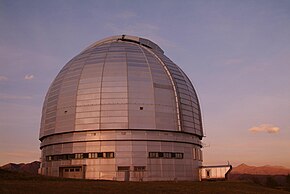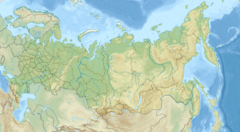 | |
| Alternative names | Large Altazimuth Telescope |
|---|---|
| Part of | Special Astrophysical Observatory of the Russian Academy of Science |
| Location(s) | Caucasus Mountains |
| Coordinates | 43°38′48″N 41°26′26″E / 43.6468°N 41.4405°E |
| Altitude | 2,070 m (6,790 ft) |
| Wavelength | 0.3, 10 μm (999, 30 THz) |
| First light | 1975 |
| Telescope style | Ritchey–Chrétien telescope |
| Diameter | 605 cm (19 ft 10 in) |
| Collecting area | 26 m2 (280 sq ft) |
| Focal length | 24 m (78 ft 9 in) |
| Mounting | altazimuth mount |
| Website | www |
The BTA-6 (‹See Tfd›Russian: Большой Телескоп Альт-азимутальный, romanized: Bolshoi Teleskop Alt-azimutalnyi, lit. 'Large Altazimuth Telescope') is a 6-metre (20 ft) aperture optical telescope at the Special Astrophysical Observatory located in the Zelenchuksky District of Karachay-Cherkessia on the north side of the Caucasus Mountains in southern Russia.
The BTA-6 achieved first light in late 1975, making it the largest telescope in the world until 1990, when it was surpassed by the partially constructed Keck 1. It pioneered the technique, now standard in large astronomical telescopes, of using an altazimuth mount with a computer-controlled derotator.
For a variety of reasons, BTA-6 has never been able to operate near its theoretical limits. Early problems with poorly fabricated mirror glass were addressed in 1978, improving but not eliminating the most serious issue. But due to its location downwind of numerous large mountain peaks, astronomical seeing is rarely good. The telescope also suffers from serious thermal expansion problems due to the large thermal mass of the mirror, and the dome as a whole, which is much larger than necessary. Upgrades have taken place throughout the system's history and are ongoing to this day.
